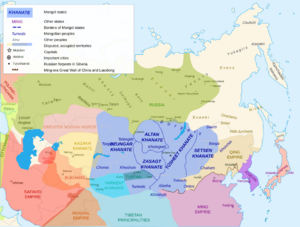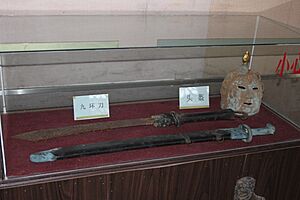Qing invasion of Joseon facts for kids
Quick facts for kids Qing invasion of Joseon |
|||||||
|---|---|---|---|---|---|---|---|
| Part of Korean–Jurchen conflicts, Ming-Qing transition | |||||||
 |
|||||||
|
|||||||
| Belligerents | |||||||
| Qing dynasty | Joseon dynasty Ming dynasty |
||||||
| Commanders and leaders | |||||||
| Hong Taiji Dorgon Ajige Dodo Hooge Oboi Kong Youde Geng Zhongming Shang Kexi Shi Tingzhu Inggūldai |
Im Gyeong-eop Shin Gyeong-won Hong Myeong-gu † Kim Jun-yong Min Yeong † Shen Shikui † |
||||||
| Strength | |||||||
| 100,000 | 80,000–90,000 | ||||||
| Casualties and losses | |||||||
| Unknown | Unknown | ||||||
| Korean name | |
| Hangul |
병자호란
|
|---|---|
| Hanja | |
| Revised Romanization | Byeongja Horan |
| McCune–Reischauer | Pyŏngcha Horan |
The Qing invasion of Joseon was a big war in the winter of 1636. The new Qing dynasty attacked the Joseon dynasty (which is now Korea). This war made the Qing dynasty the most powerful country in the region. It also forced Joseon to stop being friends with the Ming dynasty.
This invasion happened after another one in 1627, called the Later Jin invasion of Joseon. The Qing invasion ended with Qing winning. Joseon had to become a "tributary" state to Qing. This meant Joseon had to send gifts and show respect to Qing. Joseon's crown prince and his younger brother were taken as hostages. They returned to Joseon after a few years. One of them later became King Hyojong. He is famous for wanting to invade the Qing dynasty later.
Contents
What Was the Qing Invasion Called?
In Korean, the Qing invasion (1636–1637) is known as Byeongja Horan (병자호란). The year 1636 was a Byeongja year in the old calendar system. Horan means a problem caused by foreigners from the north or west. It comes from ho (meaning northern people) and ran (meaning chaos or disorder).
Why Did the Qing Invade Joseon?
After the 1627 invasion, Joseon was still unsure about the Qing dynasty. Qing accused Joseon of helping people who ran away and giving food to the Ming army. Also, Joseon did not accept Hong Taiji as the new leader of the Qing dynasty.
Tensions Rise Between Joseon and Qing
Qing leaders, like Inggūldai and Mafuta, visited Joseon's capital, Hanseong. But King Injo of Joseon did not welcome them. He even refused to meet them or send a letter. This made the Qing leaders very angry. They found a message from Joseon that showed Joseon was preparing for war.
Qing princes were furious about Joseon's actions. They wanted to invade Joseon right away. But Hong Taiji decided to attack the Ming dynasty first. Qing forces got very close to Beijing, the Ming capital. This showed that Ming's defenses were weak. After this success, Hong Taiji decided to attack Joseon in December 1636.
Before the invasion, Hong Taiji sent his generals to block the sea routes to Korea. This was to stop the Ming dynasty from sending help. Some Ming generals, like Kong Youde, Geng Zhongming, and Shang Kexi, had joined the Qing side. They helped Qing with their ships and soldiers.
Joseon's Lack of Preparation
Joseon was not ready for a war. In 1634, a Ming official visited Joseon. He asked for a lot of money for a ceremony. Ming merchants also tried to force unfair deals on Joseon traders. This visit cost Joseon a lot of silver.
King Injo also faced problems at home. He tried to honor his late father, but many government officials disagreed. Also, a royal tomb was accidentally damaged in 1635. These political arguments stopped Joseon from getting ready for a possible invasion from Qing.
Breaking Diplomatic Ties

In February 1636, Qing leaders visited Joseon for a funeral. They brought many high-ranking officials from recently conquered Mongolian tribes. Their real goal was to show off Qing's growing power. They also wanted to see if Joseon would accept Hong Taiji as the new "Emperor."
Joseon was shocked because they only saw the Ming Emperor as the true emperor. Many people in Joseon became very hostile towards Qing. Qing's envoys even faced danger from students and soldiers. Finally, they had to leave Joseon. This basically ended the diplomatic relationship between Qing and Joseon.
In April 1636, Hong Taiji became Emperor and changed his country's name from Later Jin to Qing. Joseon's envoys at the ceremony refused to bow to him. The Emperor sent a message back with them. It said that Qing would invade Joseon unless Joseon changed its policies. Qing also demanded one of Joseon's princes as a hostage.
After hearing this, Joseon's leaders who wanted war gained more power. Joseon sent a message back to Qing in June 1636. It blamed Qing for the bad relationship between the two nations.
The Final Days Before War
Now, Joseon had to prepare for war. But King Injo was afraid of fighting the powerful Qing army. He listened to advice to send messengers to Qing to seek peace. These messengers gathered some information but could not meet Hong Taiji. This made the war supporters in Joseon even angrier. King Injo sent another group of messengers in December, but it was too late. Qing had already started its invasion plan on November 25.
The War Begins
On December 9, 1636, Hong Taiji led his army to attack Joseon. His army included soldiers from the Manchu, Mongol, and Han Chinese groups. Chinese soldiers were especially important for their artillery (cannons) and navy.
General Im Gyeong-eop and his 3,000 men bravely defended the Baengma Fortress. They held off 30,000 Qing soldiers led by Dodo. Dodo decided to go around the fortress instead of attacking it directly. Other Qing forces also bypassed Joseon's northern fortresses.
Dorgon and Hooge led a fast Mongol force straight to Hanseong (Seoul). They wanted to stop King Injo from escaping to Ganghwa Island, as he had done in the previous war. On December 14, Hanseong's defenders were defeated, and the city was captured. Fifteen thousand Joseon troops from the south tried to help, but Dorgon's army defeated them.
King Injo and about 13,800 soldiers took shelter in the Namhan Mountain Fortress. This fortress did not have enough food for so many people. Hong Taiji's main army, 70,000 strong, surrounded the fortress. Joseon forces from other parts of the country tried to help King Injo.
On January 28, 5,000 Joseon soldiers fought 6,000 Manchu soldiers. The Manchu cavalry tried to attack many times but were pushed back by Joseon's muskets. The Manchu army then went around a mountain and surprised the Joseon troops from behind, defeating them. Other Joseon forces fought better and defeated Manchu attacks throughout the day. The Joseon soldiers inside the fortress also defended it well against Manchu attacks for several weeks.
Even with little food in January 1637, Joseon's defenders fought back. They even blew up a Qing artillery base, killing its commander. Some walls of the fortress were damaged but were repaired overnight. However, on January 27, Dorgon captured Ganghwa Island. He also captured King Injo's second son and his wives. King Injo surrendered the next day.
The Peace Treaty
King Injo surrendered at the Han River. He gave up his official seals from the Ming dynasty and handed over three officers who had supported the war against Qing. He also agreed to these peace terms:
- Joseon had to stop using the Ming calendar and official items.
- King Injo's first and second sons, along with sons or brothers of ministers, had to go to Shenyang as hostages.
- Joseon had to use the Qing calendar.
- Joseon had to accept Qing as its new overlord.
- Joseon had to send soldiers and supplies to help Qing fight the Ming dynasty.
- Joseon had to provide warships to transport Qing soldiers.
- Joseon and Qing ministers should marry each other's family members.
- Joseon could not allow refugees from Qing territory to enter.
- Joseon could no longer build or rebuild fortresses.
Hong Taiji set up a special platform at Samjeondo. King Injo knelt three times and bowed nine times, just like other subjects of the Qing court. A monument was built at Samjeondo to honor the "excellent virtues of the Manchu Emperor." As part of the surrender, Joseon sent troops to attack Ka Island.
A Ming officer on Ka Island fought bravely for over a month. But Qing forces, including former Ming soldiers, landed on the island. The Ming officer refused to surrender and was killed. The Ming general then moved his remaining forces out of Korea.
What Happened After the War?
Many Korean women were kidnapped by the Qing forces. In 1648, Joseon had to send some royal princesses to marry Qing princes. For example, Princess Uisun was adopted by King Hyojong and then married Prince Dorgon.
Koreans still felt angry towards the Qing dynasty in private. They thought the Manchu people were "barbarians." Joseon scholars secretly used Ming calendar names even after the Ming dynasty fell. Some Koreans believed Joseon should have been the true successor to Chinese civilization instead of the "barbaric" Qing. Even though the peace treaty said Joseon could not build fortresses, new ones were built around Hanseong and in the north.
The future King Hyojong lived as a hostage in Mukden (Shenyang) for seven years. During his ten years as king, he planned an invasion of Qing called Bukbeol (Northern expedition). However, he died before he could carry out his plan.
From 1639 until 1894, Joseon trained people to translate Korean and Manchu. They used new textbooks written in the Manchu script. The Manchu language became very important for official exams.
For a long time, Koreans saw the Qing invasion as more important than the Japanese invasions of Korea from 1592 to 1598. The Japanese invasions were terrible, but they did not completely defeat Joseon. Being defeated by the "barbarian" Manchus and the fall of the Ming dynasty had a deeper impact on Korean society. The Japanese invasions did not change the overall world order. It was only much later, when Japan became powerful in the 1800s, that the 16th-century Japanese invasions became more significant in Korean history.
See also
- Later Jin invasion of Joseon
- History of Korea
- Samjeondo Monument
Images for kids



